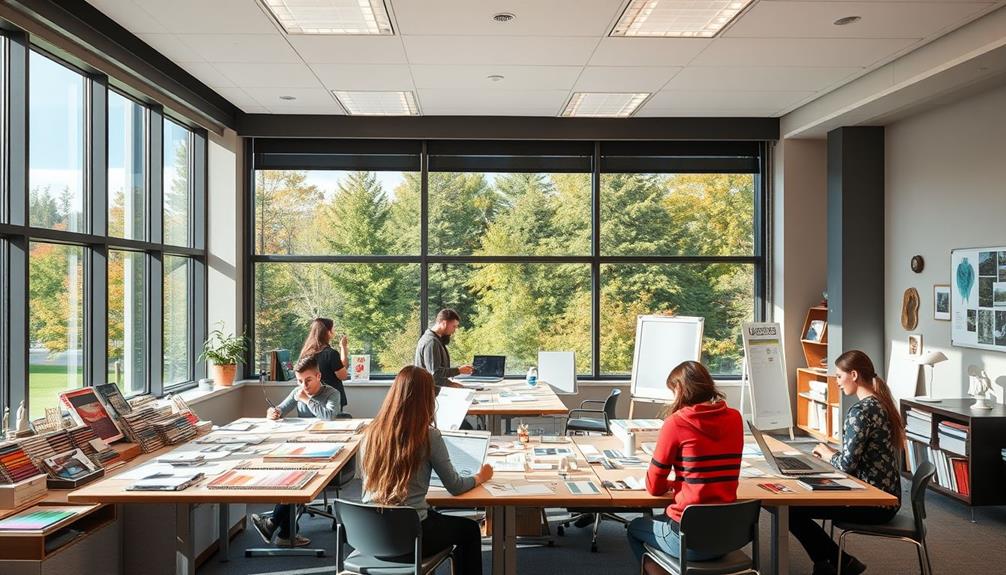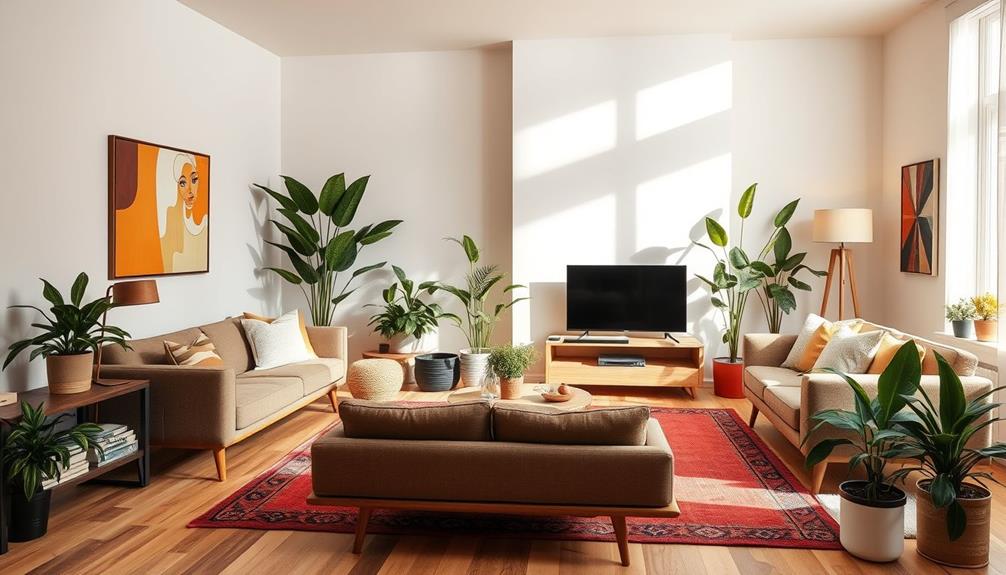To become an interior designer, start by evaluating your skills and passions. You'll need formal education, so consider enrolling in an accredited program, like a Bachelor's degree. Completing the NCIDQ exam is vital for licensure. Gain practical experience through internships and mentorships to build your portfolio. Networking plays an important role in your career, so join professional organizations and attend industry events. Keep your portfolio updated with your best work, showcasing your versatility. With dedication and the right connections, you'll put yourself on the path to success. There's much more to explore about this exciting journey. Consider specializing in a particular niche, such as residential or commercial design, to further enhance your expertise. You may also consider becoming an interior design consultant, offering your services to clients on a freelance or independent basis. This can provide you with more flexibility and opportunities to work on a variety of projects. By staying updated on the latest trends and innovations in the industry, you can continue to grow and thrive as a successful interior designer.
Key Takeaways
- Assess your motivations and skills to differentiate between interior decorators and accredited interior designers before pursuing a career.
- Obtain a degree from an accredited program and pass the NCIDQ exam for licensure in many states.
- Gain practical experience through internships, mentorships, and community projects to build your skills and connections.
- Network by joining professional organizations and attending industry events to enhance career opportunities and insights.
- Develop a strong portfolio showcasing diverse design projects, regularly updating it with new work and achievements.
Self-Assessment and Career Planning
Before diving into a career in interior design, it's vital to reflect on your motivations and skills. Start with a self-assessment to gauge your passion for design and your creative abilities.
Consider whether you're drawn more to decorating, focusing on aesthetics, or to the broader aspects of interior design, which include space planning and functionality.
Understanding the distinction between interior decorators and accredited interior designers is important, as the latter typically requires formal education and certification.
Think about your preferred design areas—residential, commercial, healthcare, or education—to guide your educational and career choices.
As you engage in career planning, evaluate your existing design skills and identify gaps that may need addressing through education or professional development.
Factor in the time necessary for each step, from gaining experience to building a strong portfolio. This realistic timeline will help you achieve your interior design career goals more effectively.
Education and Certification Requirements

To kickstart your career in interior design, you'll need to choose the right degree, whether it's a two-year Associate's or a four-year Bachelor's program.
After completing your education, you'll have to tackle the NCIDQ exam, which tests your knowledge and skills in various aspects of the field.
Understanding these requirements is essential for setting yourself up for success as a licensed interior designer.
Degree Options Available
Typically, aspiring interior designers have several degree options to choose from, which can greatly impact their career paths. You can pursue a Bachelor's degree in interior design, which typically requires four years of study, or opt for a quicker Associate's degree in interior design that takes about two years to complete.
It's essential to enroll in accredited interior design programs, as accreditation from the Council for Interior Design Accreditation (CIDA) guarantees that your education meets industry standards.
Your degree in interior design should cover fundamental coursework such as drawing, computer-aided design (CAD), art history, and color theory to prepare you for professional practice. Additionally, hands-on experience is critical, as you'll need to fulfill specific work experience requirements before qualifying for the National Council for Interior Design Qualification (NCIDQ) exam.
This exam is a key step in becoming a licensed interior designer and consists of three parts: IDFX, IDPX, and the practicum, each evaluating different areas of your interior design knowledge and skills.
With the right degree and experience, you'll be well on your way to a successful career in interior design.
NCIDQ Exam Overview
The NCIDQ exam stands as a significant milestone for aspiring interior designers, measuring your knowledge and competency in the field. To become eligible for the NCIDQ exam, you need a degree in interior design from an accredited program, along with a specified amount of work experience. This guarantees you have both the theoretical knowledge and practical skills necessary for success.
The NCIDQ exam consists of three parts: the Interior Design Fundamentals Exam (IDFX), the Interior Design Professional Exam (IDPX), and the practicum that evaluates your practical application of design skills. Passing these exams not only showcases your expertise but is often a requirement for licensure in many states, allowing you to legally use the title of "interior designer."
After obtaining certification, it's vital to engage in continuous education to maintain your NCIDQ credentials. This ongoing learning keeps you informed about industry standards and evolving practices, making sure you remain competitive in the field.
Selecting an Interior Design School

When you're selecting an interior design school, make certain to look for programs accredited by the Council for Interior Design Accreditation (CIDA), as this guarantees you're receiving a quality education.
Don't forget to visit potential schools to get a feel for the atmosphere and talk to current students and faculty about their experiences. This firsthand insight can help you evaluate how well a program aligns with your career goals.
Program Accreditation Importance
Choosing an interior design school with accredited programs is crucial for your future career, as it directly impacts the quality of education you'll receive. Accreditation by the Council for Interior Design Accreditation (CIDA) guarantees the program meets industry standards, providing you with the formal education necessary for professional practice.
When you graduate from an accredited program, you typically become eligible to take the National Council for Interior Design Qualification (NCIDQ) exam, a critical credential for licensure in many states. This credential can greatly enhance your job prospects in a competitive market, as employers often prefer candidates with recognized educational backgrounds.
Notable accredited programs, such as those at the University of Cincinnati or Cornell University, have strong job placement rates, which can further boost your career opportunities.
Additionally, attending an accredited school can foster valuable connections with design professionals, giving you access to networking opportunities that may lead to internships and job placements after graduation.
School Atmosphere Evaluation
Evaluating the school atmosphere is essential for finding the right interior design program that suits your needs. When you visit potential interior design schools, pay attention to the facilities and resources available, as these can considerably impact your learning experience.
Engaging with current students and faculty during your visits or open houses will give you valuable insights into the school's culture, teaching methods, and support systems.
Make certain to assess the school's accreditation, especially from recognized bodies like the Council for Interior Design Accreditation (CIDA). This guarantees that the program meets quality standards and enhances the credibility of your education.
Additionally, consider the location of the school and its connections to local design firms, as these factors can greatly influence internship opportunities and job placement rates after graduation.
Gaining Practical Experience

Gaining practical experience is essential for aspiring interior designers, as it bridges the gap between theoretical knowledge and real-world application. One of the most effective ways to gain experience is by completing internships at design firms. These opportunities provide hands-on experience and help you build industry connections vital for job placements after graduation.
Participating in mentorship programs can further enhance your journey, offering guidance from seasoned professionals who can help you navigate the complexities of the field. Engaging in pro bono projects or community design initiatives not only sharpens your practical skills but also enriches your portfolio with diverse design solutions.
Additionally, working in related fields like architecture or construction can provide valuable insights into the technical aspects of design, improving your understanding of how various elements interact in a space.
Don't overlook the importance of attending design workshops and industry events. These experiences allow you to learn about the latest trends, tools, and techniques while expanding your professional network within the interior design community.
Building a Professional Network

After acquiring practical experience, it's time to focus on building a professional network that can support your interior design career.
Joining professional organizations like the International Interior Design Association (IIDA) or the American Society of Interior Designers (ASID) offers valuable networking opportunities and industry insights. These associations often host design events where you can meet established professionals and cultivate relationships that might lead to mentorship or job opportunities.
Don't underestimate the power of online design communities and social media platforms like LinkedIn and Instagram. Engaging in these spaces can expand your network by connecting you with other designers and potential clients.
Additionally, participating in internships and volunteer projects not only gives you practical experience but also helps you establish connections with industry professionals who can offer referrals and support.
Developing Your Portfolio

How can you effectively showcase your skills as an interior designer? Start by developing a strong portfolio that includes a variety of design projects. This variety reflects your unique style and your ability to tackle different challenges. High-quality photographs of completed projects are essential—include detailed descriptions and before/after images to demonstrate your creativity and design capabilities.
Regularly updating your portfolio is vital. Incorporate new work from school projects, internships, and personal designs to keep it relevant and showcase your growth as a designer. Consider both digital and traditional formats; digital portfolios are particularly beneficial as they can be easily shared with potential clients and employers.
Engaging in design competitions and pro bono projects can also enhance your portfolio. These opportunities not only provide additional content but also help you sharpen your skills and increase your visibility within the industry.
Conclusion
As you commence your journey to become an interior designer, think of yourself as a blank canvas waiting for vibrant colors and textures to come alive. Just like a painter carefully chooses their palette, you'll select your education, experiences, and connections to create a masterpiece of a career. Remember, every great designer started somewhere—embrace your unique style, stay curious, and watch your dreams unfold like a beautifully designed room, inviting and full of life.







